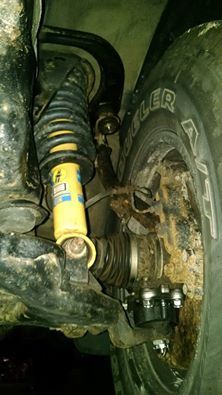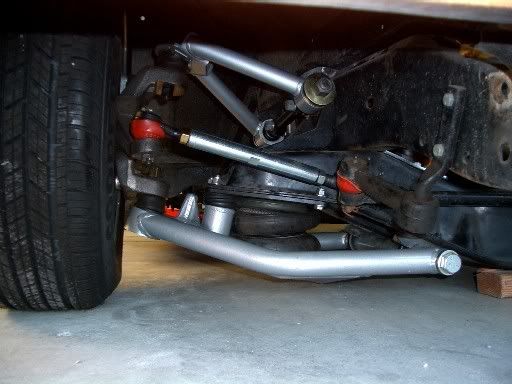
Was doing some work on the Sequoia front suspension (balljoints, bushings, etc) and looking at the way this suspension is set up, it seems like a terrible design. Double-wishbone obviously, with the load-bearing being on the lower control arm. Pretty typical, right? But I don't understand why the lower balljoint is ABOVE the LCA - since that setup seems to put the ENTIRE weight of the vehicle pulling downward on the balljoint and loading on the balljoint lower nut and nothing else (i.e. if the nut threads fail, the LCA separates from the spindle). I would think that the balljoint should be below the spindle so that even if the balljoint or nut fails, it would still remain in the hub because it's seated in the taper. But the way it actually is, the taper on the balljoint where it passes through the spindle only appears to be for locating, and isn't actually holding any load (except on droop, I suppose). The upper control arm balljoint seems to really be carrying no load at all (just locating the spindle).
I know that Toyota had a huge recall on Sequioas, 4Runners, Tundras, etc with this design for a lower balljoint issue (this truck was apparently fixed under that recall) - but I've never really figured out what the "fix" was for this: larger balljoint? different balljoint design? The forums seem to have a lot of talk about balljoint failures on these trucks in an abstract sense, but for as many tens of thousands that have been sold, I can only find a few examples of actual failures ("Rota wheels" syndrome?).
I always felt this truck was solid Toyota quality, but I'll. admit that I feel a bit nervous now. This is my wife's truck that hauls my kids around (and I tow the race car with it), so safety is top-priority on those accounts. So should I not worry at all about this? Am I looking at the forces involved wrong? Or is the bottom line that the LBJ and nut are simply plenty strong enough that the weight of a 5500lb vehicle with big, heavy wheels and tiers is not an issue?

And in fact, looking at the current-generation Sequioa/Tundra.....they actually DID switch the arrangement....

I'd guess that if it's properly engineered and assembled the taper alone should hold, and that stud/nut is also more than likely plenty strong.
Consider that the tensile yield strength of run of the mill 1018 cold rolled steel is 53700 psi, or in other words, a bar with a cross section of one square inch will not permanently deform until you put nearly 27 tons of pull on it, and it won't actually break until you hit the ultimate strength of 63800 psi. A ball joint stud is going to be made of stronger steel.
That said, it is a crappy design for reasons you outlined.
I had a friend in high school who had the front spindle pop out three times on his 4x4 turndra that was maybe a 2000? None of it was offroad
The entire weight of the front end is almost always carried by the lower ball joint. Realistically, there is no difference between the first picture, and every Chevrolet pickup truck built since 1960- its just upside down.
Yeah, I'm sure with tens of thousands of Toyotas on the road with this setup I'm just being paranoid. Maybe because I just noticed this setup before I am about to tow 700 miles lol....
It's an unusual design, but is not actually loading the ball joint itself any differently than a 'conventional' setup that has the ball joint as part of the lower control arm, mounted below the spindle, and just a tapered hole in the spindle...Yet as far as I'm aware, this is how pretty much all lower ball joints were configured until the last 20 years or so when they started playing with alternative designs.
I understand your point about a possible structural weakness. I have notice some really unusual suspension set ups on newer vehicles. I have a 2008 Nissan Pathfinder V8 with IRS. I bought it because it is rated at 7000 lb tow capacity. I don't like the way it tracks. The IRS has TWO lower control arms, one holds the bottom of the coil spring and the other holds the ball joints. Weird in my opinion. Anyway, I wonder if the Toyota suspension you are talking about has to do with such things and roll center, instant center, ackerman & bump steer. Things I hardly understand but have read many articles about. Lowering the ball joint pivot point would have a major effect on those things.
Put me in the "that's berkeleying stupid" camp. I'm sure some engineers were very frustrated but that ended up being the most cost effective solution.
Maybe they did it that way because it's a parts bin engineering job. Maybe they needed the extra angle in the control arm to locate the roll center in the middle of the engine block so it didn't feel tippy. Or maybe it was to make room to clear the axles. Or because they bought a whole mess of them for a different application and needed to use them up.
Still - to the ball joint, the load is the same. It just looks a little odd.
In reply to ¯_(ツ)_/¯:
Ding ding, engineering by accounting
It works just fine. The load is actually held by the stud taper, not the nut itself. It's a righteous press fit.
That said, you want the ball joint to be mounted "under" instead of "over" if you want the suspension pivot to be far away from the axle centerline. Which most people do, if they want the vehicle to not handle like a wallowy turd.
You don't have to pull the axle to service the ball joint in the original design.
But you do have the weight of the vehicle trying to pull everything apart.
It's designed that way because it's designed to work with all the parts. Missing castle nuts equal an incomplete suspension.
Boys...Pay attention. There is no difference in loading between the picture you have above, and this one:

Its kinda 6 of one/half a dozen of another. With the ball joint on top, you're dealing primarily with tensile strength which is more than adequate. I think you would rip the control arm before you pulled the stud apart. With the joint on the bottom you're dealing primarily with shear strength (something at which harder steel is not necessarily as good). Either way, if the stud snaps, the wheel spindle is loose. Same net result. I just don't think that the ball joint is the weak part.
I have only had a couple of cars with a-arms. The majority of my cars have had struts or torsion bars (or a combination of both). Of the cars I have had with A-arms, that is how they are set up with the bottom balljoint being "pulled apart"
I would say that falls squarely under my favorite engineering caveat: its fine in theory and even for the most part in practice, but since you CAN conceive of that failure mode it will happen to somebody.
¯\_(ツ)_/¯ wrote:
Put me in the "that's berkeleying stupid" camp. I'm sure some engineers were very frustrated but that ended up being the most cost effective solution.
apparently it was this setup when the OLD Toyota trucks had the upper wishbone a torsion arm, so the upper balljoint was actually load-bearing and the lower was mostly just for locating suspension. Then when they changed it to a coilover setup, the lower wishbone became load-bearing but they didn't reverse the balljoint.
BA5 wrote:
I would say that falls squarely under my favorite engineering caveat: its fine in theory and even for the most part in practice, but since you CAN conceive of that failure mode it will happen to somebody.
apparently it happened to a lot of somebodies, which is why Toyota recalled a decade's worth of trucks. Just google "Tundra balljoint failure" (or 4Runner or Sequoia or Tacoma) and a lot of gnarly pictures come up olol...
My 1st Gen Tacoma is setup exactly like this. I've never heard of balljoint failure on them. Mine survived jumping an intersection and hundreds of miles of pounding desert with no issues so far.
Just file it with all the other internet lore.
10-bolt axles are weak.
BMW final drives are garbage.
Assembled SBCs only weigh 300 lbs.
Tacoma balljoints are all about to fail.
Mustang fox bodies lower ball joints are the same way. The spring is sandwiched between the lower A arm and the front sub frame. The only time I broke a ball joint the A arm caught on the inside of the rotor. I learned that when you steering gets hard it is time to change your ball joints. Other wise they are in there to stay.

jstand
HalfDork
10/9/16 8:26 a.m.
irish44j wrote:
BA5 wrote:
I would say that falls squarely under my favorite engineering caveat: its fine in theory and even for the most part in practice, but since you CAN conceive of that failure mode it will happen to somebody.
apparently it happened to a lot of somebodies, which is why Toyota recalled a decade's worth of trucks. Just google "Tundra balljoint failure" (or 4Runner or Sequoia or Tacoma) and a lot of gnarly pictures come up olol...
I'd be interested to know if those come from states with annual safety inspections or places where it's up to the owner to take responsibility for making sure their vehicle is safe?
As long as you don't wait until the ball joint is worn enough to pull out of the housing you shouldn't see that type of failure.
I quick look at results if a search appears that the recall is related to premature wear. That sounds like a materials selection issue and not necessarily related to the ballpoint orientation.
As long as you inspect the ball joints for wear regularly and replace once you have play there shouldn't be any problems.
jstand wrote:
As long as you inspect the ball joints for wear regularly and replace once you have play there shouldn't be any problems.
This.
People don't freak out over tie-rod ends being mounted in single shear, and those come apart far more frequently than ball joints do.
If you wanted to compile a list of vehicles that have load-bearing ball joints loaded in tension, you'd have to start with "every RWD American car ever made except Fords with shock towers" and include a lot of European and Japanese cars, like wishbone Hondas and all Miatas...













































